GAUSS
BREAKING: 8 pages of kind words by legendary German High End critic Joachim Pfeiffer “Finally a useful accessory that will blow your mind when you refine your hi-fi chain with it.” writes the head of German HIFI SOUND&MUSIC and dedicates 8 pages to our invention. Read here, with English translation on the last page. VERDICT: “Tip of the Year. No other accessory I know of improves your sound on this level – without any letdown.”
PDF_Flyer_GAUSS_DoppelseitenGAUSS review October 2022 – PDF
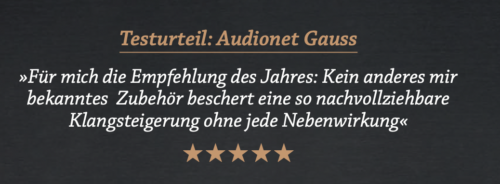
German patent for GAUSS has been granted. Improve the sound of any good system vastly with our paramagnetic invention.
“The effect is immediately audible, provided your chain is capable of displaying such nuances. Bye bye blurriness, hello true reality. We were blown away by the auditory effect…It became much easier to place instruments. These, in turn, sounded in their timbres all at once so plastic, rich in overtones and colorful…A new balance that makes us doubt whether we have ever been able to hear real High End in the past. In any case, one thing is certain: never again without it.” (AUDIO TEST, Germany)
NEW: GAUSS. A magnetic field liberator.
THE GAUSS EFFECT – or: Why does GAUSS work, how does it work, and why hasn’t anyone in 50 years of High End thought of it?
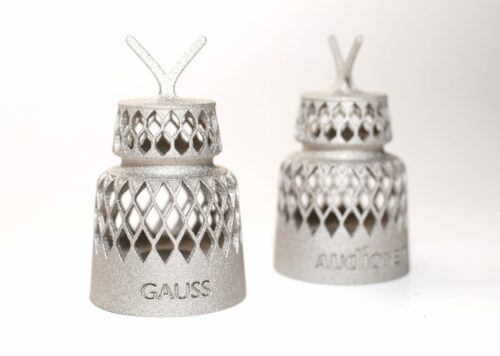
- Surprise: Never did a single electron “flow” from an amplifier to a speaker to produce a sound there. Never. Guess you and we were taught that wrong at school (the physics teacher didn’t know any better). The sun does not revolve around earth either, although it does look like it. Current does not flow! From a scientific point of view electrical power transfer consists of a magnetic field around an electrical conductor IN THE DIELECTRIC AIR which generates an energy transfer in one direction (so-called Faraday’s right-hand rule: If the fingers of the right fist point in the direction of the magnetic field, the thumb shows the direction of the energy flux. See above: This is obviously the line to the left speaker.).
- With the knowledge that the signal interacts with all substances surrounding it via the electromagnetic field over the entire length of the cable, our observation naturally lead to the realization that a cable lying on the ground is in contact with different materials with very different permeability and permittivity numbers (Both count! Believe us!). And every object in the electromagnetic field changes the signal. The sound improves immediately if the cable is surrounded by only one material, ideally with the highest possible magnetic permeability (the lower the so-called permeability number, the higher the magnetic permeability, iron, for example, has a massive 800-8000 μr) and a permittivity which equals that of air.
- Air has a permeability number of 1,000,000.37 μr. Followed by other gases. Then comes aluminum with 1,000.02 μr and the light metal magnesium, which follows directly in the periodic table. So the solution is: As much air as possible and the feet paramagnetic, i.e. as close to air as possible, numberwise. That’s why we constructed GAUSS from a patented alloy of Al and Mg with minimal contact point in relation to the cable.
-
We report verbatim from our very first own test: Audionet WATT playing on Dynaudio Confidence Platinum C2. “The system was warming up, we were conferencing next door. Eventually we listened. Didn’t that sound better even while warming up? More right? More true? Suddenly there was a crowd at the entrance to the listening room. We put Coltrane/Ellington, “My Little Brown Book” on. 1970’s Japanese pressing produced by Bob Thiele and the legendary Rudy van Gelder in Hackensack, NJ in 1962. Very subtle, great transients, tonally as correct as it gets.
And that suddenly sounded even more correct. Touchable. Even more “in the room”. Tranes Sax no longer came out of the right speaker, but stood diagonally to the left behind it. Jimmy Garrison’s bass was hands-on. And at the end of the track Elvin Jones found some tiny licks that had previously been lost and were now suddenly THERE. - Wow. That exceeded our wildest expectations. We removed the GAUSSes and played the same track. It had to be an illusion, our concept COULDN’T work out that well. But the magic from before was gone. Something was missing that we hadn’t previously known was there. GAUSS underneath again: Yes, there it was back. Incomprehensible. Other music on. Bill Evans, “How my heart sings”, 45 rpm, Riverside special. More Steinway, nicer Steinway, more flickering and afterglow. And Paul Motian’s wrists suddenly seemed to become even more flexible.”
- Same effect. Invigorated, refreshed, more tangible. That’s what high end is all about. Magically brought to life through scientific thinking. We were a little surprised that we’d been so right, actually. Our little paramagnetic alien, which we designed to maximize performance and for practical reasons in such a way that it is now reminiscent of the Command Module of the first Apollo moon landing mission (“Endeavour”), is not cheap, it is very complex to manufacture. Compared to what it gives you, though, it’s quite a bargain.
-
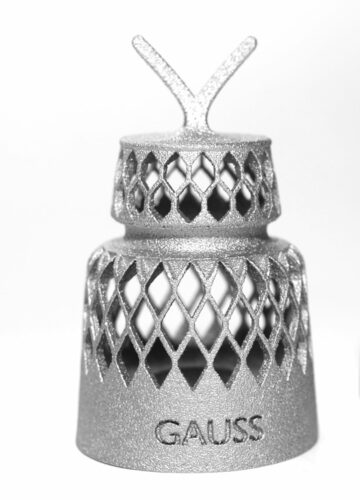
We would be happy if many really sensitive high-end users and especially happy Audionet owners would have the same experiences as we did. Get your set of GAUSS from your dealer or distributor in your country. You’re going to need between 4 and 10 pieces, depending on the length and rigidity (or lack of it) of your speaker cables. GAUSS works with ALL speaker cables between 0.5 and ca. 8cm diameter. If you’re in doubt, try them out. At this point we would like to quote one of the first GAUSS customers, owner of a €70,000 system, verbatim and without stating his name: “These things stay here! I don’t know why they work. But they work.”
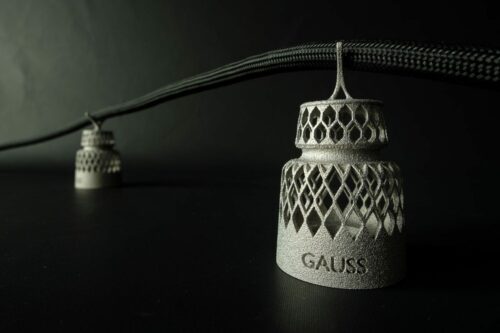
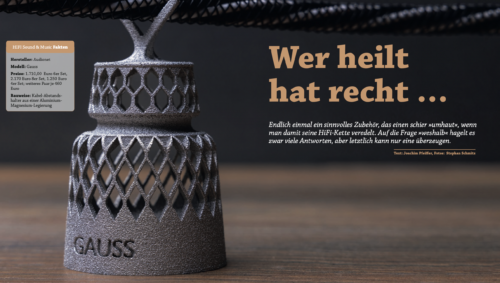
Joachim Pfeiffer in HIFI SOUND&MUSIC on GAUSS:
PDF_Flyer_GAUSS_DoppelseitenReview
Full text:
Test verdict: Audionet GAUSS »For me, the recommendation of the year: No other accessory I know of gives such a comprehensible increase in sound without any side effects«
HE WHO HEALS IS RIGHT
“Finally a useful accessory that will blow your mind when you refine your hi-fi chain with it. There are many answers to the question »why« but in the end only one is convincing.
Each era has its own language. What is generally true is also evident in high fidelity. Decades ago testers primarily took measurings and announced within strict limits what was good and what was bad. At the end of the 1970s, competition came into focus. The corresponding reports read like comments on a sporting event. In the end there was always a winner on the podium, although this test winner did not own the world – but the market. The perceived value of measurings faded and in some print titles they even disappeared completely. Instead, prose found its way into magazines.
The language used in it henceforth hardly ever proclaimed winners, but rather relativized and levelled: one product can do this, another that, in the end you decide, dear reader (or customer). Everything is somehow good. But when everything is just fine, credibility suffers. A very special use (sometimes also: consumption) of language was also established for the diverse realm of accessories.
Clear announcements and confessions became quite rare and more and more stories were found (and still are) that seem to be written according to one and the same knitting pattern. Freely based on the following director’s instructions: Well, I (the tester) am skeptical by nature, but this or that part has an effect on my equipment. And so as not to risk any trouble or provoke contradiction, of course only in “my” system. You, dear reader/customer, can try it out for yourself… Maybe you share my experience (…and you don’t want to hear it anymore without the accessories) or you don’t. Both are correct. Clear statements and announcements, comprehensible purchase recommendations? Not in this life.
GAUSS is a spacer for speaker cables that is both visually and haptically unconventional. I gave a set of 6 to a colleague who spent many long weeks working on it. He probably won’t be able to handle it, I thought. This colleague is an engineer from head to toe and the holder of a great number of patents. Not a dreamer, definitely a pragmatist, but nonetheless pleasantly curious. However, he appeared to be fairly unimpressed by the patent that GAUSS inventor Jan Geschke was given by the German authorities. Weeks passed and we didn’t spoke a word about GAUSS.
Until that memorable day on a long weekend. “You absolutely have to come. Instantly. Stante pede. Subito.” In front of me, correctly distanced, stands the Avantgarde acoustic »Trio«, fed by excellent electronics from various manufacturers, as is usual in this listening room.
The important thing is that my colleague and I know how this constellation sounds like, we have spent countless days listening to it. For example with »The Well« by Jennifer Warnes. Listening to this piece with the Trio is
comparable to a walk in the forest: you know every path, every tree or bush – and yet the listener who walks discovers something new again and again. Yes, that sounded pretty good that afternoon. “Now watch out,” my friend whispered in my ear, pushing a few conventional spacers under Mogami’s speaker cables: the sound changed. Only about nuances, but these were enough to shake your head: „Sounded somehow clearer before!”. Not a spectacular difference, but still.
Okay, then again without. That’s right, now the world is back in the stereophonic triangle again. My counterpart smiles and then throws a special punch.
“Now I’m going to place these Audionet spacers called “Gauss” under the Mogami, assess whether and if so: how the sound changes!” What HAPPENED here?!? Far more than expected. The guitar, with the GAUSS now in/below the signal path, sounded more three-dimensional, Madame Warnes’ voice suddenly was more natural – and as clear as day the entire bass range up to the fundamental tone spectrum was clearly better reproduced. The increase in resolution in the spheres from the so-called “lower mids” was astonishing, but the unusual transparency in the frequency ranges below gave this typical test track a kind of “new life“.
A more complex, more moving sound is also a guarantee for more emotions. A change like this, of this quality usually comes only from the exchange of entire components. With “mere” accessories I have heard a difference like this very, very rarely (exceptions can be counted on less than one hand: The first encounter with a Copulare rack with a DC player from Wadia for example in the 1990s).
My colleague had noticed the tonally much superior and completely surprising effect the first time he listened to the GAUSS-powered system. In order to rule out the usual suspicious causes for positive misjudgments, he repeated the tests at different times of the day. »What can I say, always the same, completely amazing result«. Now, cable spacers are nothing new. At trade fairs in the USA in particular, they can be found in almost every halfway decent demonstration. For optical reasons, possibly as a kind of appreciation for the often super-expensive connectors, less for – or not at all – tonal considerations.
What is the secret of the GAUSS towers? Or in other words: What can they do that others just can’t? In order to find out, »HiFi Sound & Music« decided on a very complex experiment. We made an impressive number of spacers of the same height made entirely of plastic and another armada made entirely of metal. And one more, which we assumed in theory could possibly even top the results of the GAUSS: with them the cable rested on an elastic surface. We didn’t achieve a comprehensible improvement with any of the alternatives, on the contrary: sometimes the performance suffered when the “homemade” blocks started to work. As the saying goes, he who heals is right. And that’s why I won’t quote a sentence from the technical explanations with which Audionet describes the function of the GAUSSES and the underlying mechanisms of action. From my point of view, these derivations, which like all physically complex facts offer some potential for malevolent attack, are not necessary at all.
The enemy of many accessories is known to be the »blind test«. Unaffected by price and brand, not knowing what is being heard, the tester makes a judgement. In an emergency, this causes nasty stressful situations, especially in front of an audience. In the past I have had to experience again and again that experienced developers in the high-end area simply refused a joint blind test with doubting editors. In the case of the GAUSS, I can only advise you to do so. Whether with the avant-garde Acoustic Trio, the sound giant Strauss MF-4, a Canton Vento Reference1, the legendary sound gem Intonation Terzian or just a Dynaudio Evoke 20: The more resolution-friendly a speaker system played, the clearer the tonal gain. A performance boost that absolutely and without a doubt justifies the high purchase price. In order to achieve something comparable, high-end aficionados usually dig much, much deeper into their wallets.”
u-Audio.com.tw


Review on u-Audio.com.tw
Johannes Strom in AUDIOTEST on GAUSS:
Review in German AUDIO TEST
likehifi.de on GAUSS:
Review in likehifi
German STEREO on GAUSS:
Interview
ROME Audio Show 2022 – SLOW SOUND, the Italian High-End Initiative, playing GAUSS with really huge cables. For better ones, visit the Audionet officer who invented GAUSS and whose phenomenal cables WITCHCRAFT and CARBON AGE we use ourselves at Voodoolabs





 Game changing products.
Game changing products.

 © Audionet GmbH
© Audionet GmbH